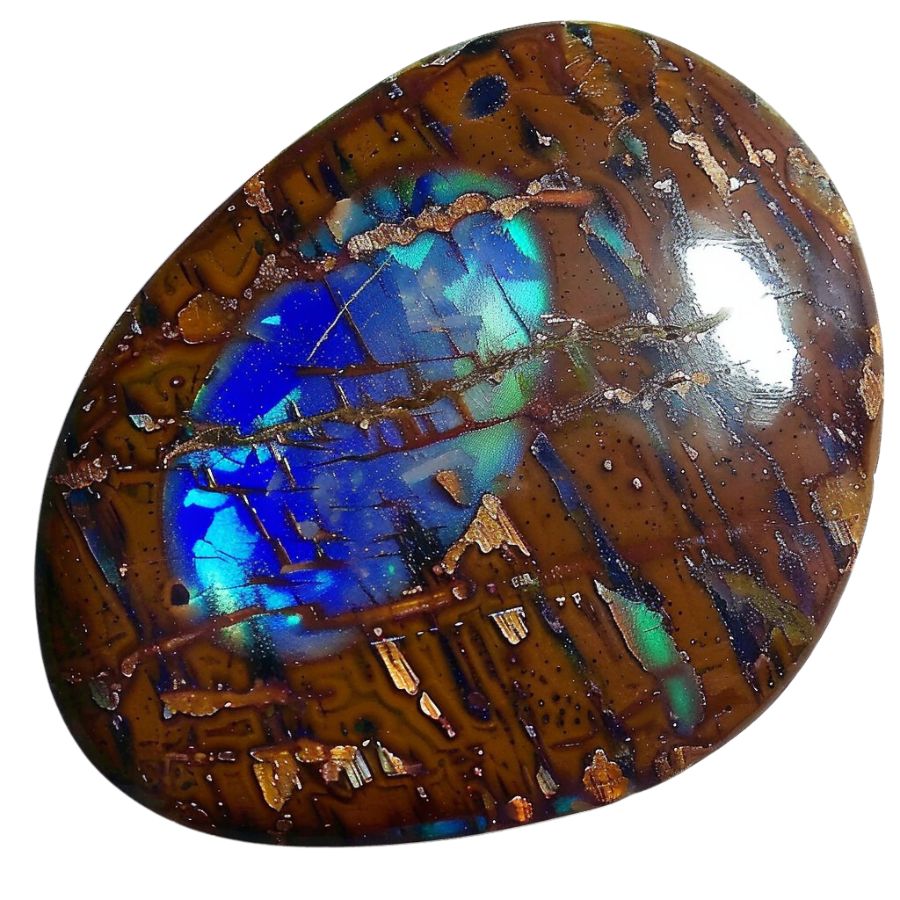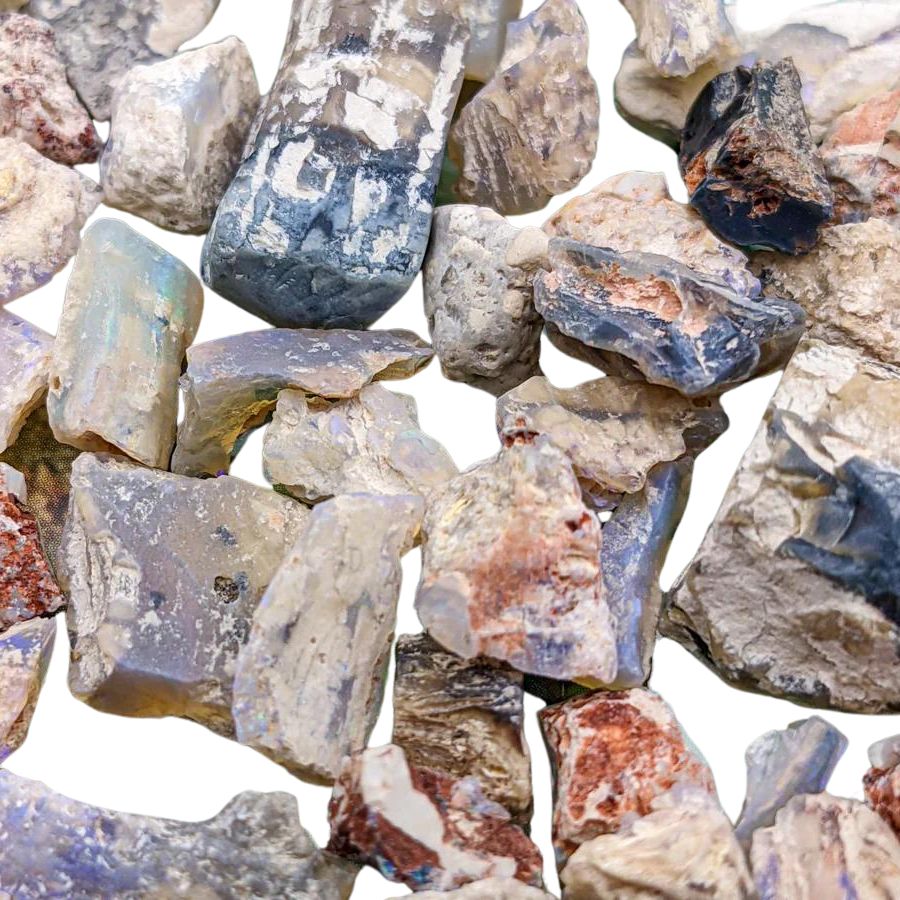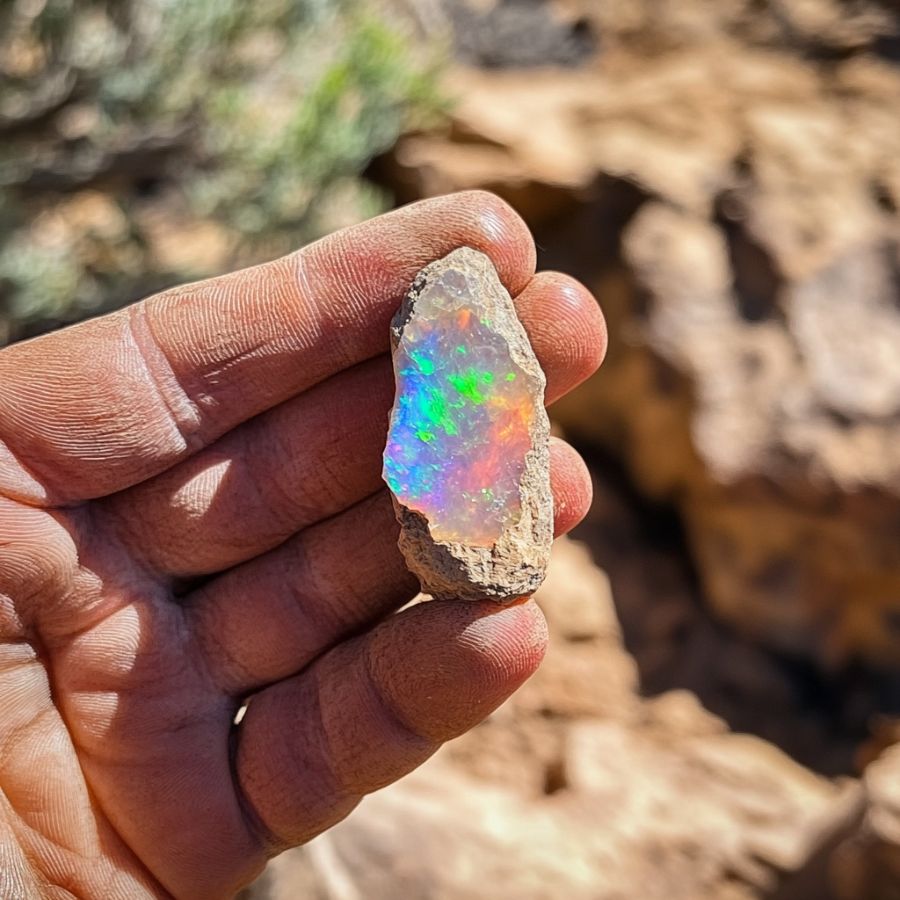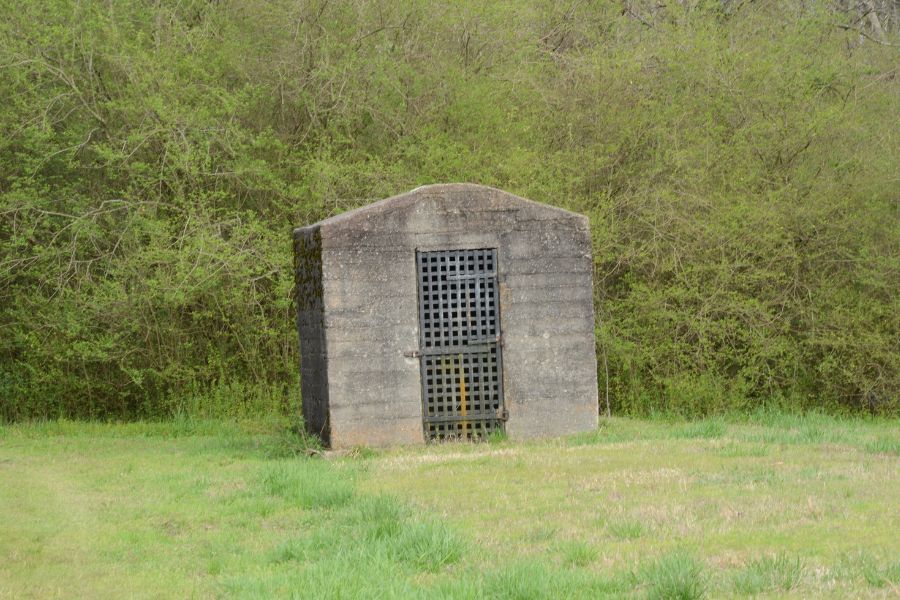Hunting for opals is an exciting adventure that combines the beauty of nature with the thrill of finding precious stones. In a state famous for its diverse landscapes, people can enjoy the quest to uncover these colorful gems.
Our state, with its special geological features, offers a great place for opal hunters. We’ll explore the best spots to find opals, the tools you need, and helpful tips for a successful hunt.
Whether you’re experienced or just starting, this guide will help you find opals in this gem-rich area.
How Opal Forms Here
Opal forms here through a fascinating natural process. When water containing silica seeps into cracks and voids in rocks, it begins to evaporate, leaving behind tiny silica spheres.
Over time, these spheres stack in a grid-like pattern, creating opal. This process can take millions of years!
The colors in opal come from the way light refracts through the silica spheres. Different conditions in the ground, like the type of rock and the presence of other minerals, can affect the opal’s type, color, and quality.
The Types Of Opal Found In The US
There are several incredible types of Opal that can be found in the US as well as in our state. Each is uniquely beautiful and interesting including:

Common Opal
Common opal, also known as “potch,” stands out from other types of opal due to its lack of play-of-color, the iridescent display seen in precious opal. Instead, common opal features consistent, solid colors like white, pink, yellow, green, and blue.
It typically has a waxy to pearly luster and ranges from opaque to translucent. To identify common opal, look for its uniform color and absence of the shimmering color flashes found in precious opal.
Common opal forms under similar geological conditions as other opals, where silica-rich water seeps into rock cavities and slowly hardens over time. This process usually occurs in areas with volcanic activity or hot springs, where silica deposits are prevalent.

Fire Opal
Fire opal is known for its warm, vibrant colors, ranging from yellow and orange to deep red. Unlike precious opal, fire opal may or may not display the play-of-color, but its fiery body color makes it unique.
To identify fire opal, look for its bright, translucent to transparent appearance and the absence or presence of play-of-color within the warm hues.
Fire opal forms in volcanic regions where water rich in silica interacts with hot lava, filling cavities and fractures within the rock. Over time, the silica solution hardens, creating opal.
Visually, fire opal’s appeal lies in its vivid, flame-like colors that can be either uniform or exhibit internal flashes of color.

Boulder Opal
Boulder opal forms within the ironstone boulders of its host rock. Unlike other opals, boulder opal features precious opal veins intertwined with the natural rock, creating a beautiful contrast.
This opal is distinguished by its combination of colorful opal patches and the surrounding matrix, which can include ironstone or sandstone. To identify boulder opal, look for its vibrant play-of-color within the darker host rock, often showcasing brilliant blues, greens, and reds.
Boulder opal forms in sedimentary environments where silica-rich water infiltrates cracks and voids within ironstone or sandstone boulders. Over time, the silica hardens into opal, often creating thin seams or patches within the rock.

Hyalite Opal
Hyalite opal, also known as water opal, is a transparent to translucent type of opal that is distinctive for its glass-like appearance and lack of play-of-color. Unlike precious opal, which displays a rainbow-like iridescence.
You can identify hyalite opal by its clear to milky appearance, often with a slight green or blue fluorescence under UV light.
Hyalite opal forms in low-temperature hydrothermal environments, typically in volcanic regions. It precipitates from silica-rich fluids that fill cracks and voids in the host rock. This process can occur relatively quickly compared to other opal types.
Visually, hyalite opal resembles droplets of water or glass, often appearing as smooth, botryoidal (grape-like) formations. Its transparent nature makes it unique among opals, and its slight fluorescence adds to its allure.

Black Opal
Black opal is a rare and highly prized variety known for its dark body tone, which enhances the vibrant play-of-color. Unlike other opals, black opal has a deep background color, ranging from dark gray to jet black, making the iridescent colors more striking.
To identify black opal, look for its intense, dark base color coupled with brilliant flashes of blues, greens, reds, and other hues.
The presence of iron and carbon contributes to its dark body color. In the United States, black opal is primarily found in the Virgin Valley of Nevada, known for its rich opal deposits.

Crystal Opal
Crystal opal is known for its transparent to translucent body, which allows the play-of-color to shine through brilliantly. Unlike common opal, which is opaque, crystal opal’s clear or semi-clear nature enhances its vibrant internal colors.
To identify crystal opal, look for its see-through quality combined with flashes of color that can include blues, greens, reds, and more.
Its unique transparency sets crystal opal apart, making it a favorite among gem enthusiasts and collectors for its ethereal beauty.

Wood Opal (Opalized Wood)
Opalized wood is a fascinating form of petrified wood where the organic material has been replaced by opal. Unlike other opals, opalized wood retains the original structure and texture of the wood, creating a unique blend of organic and mineral elements.
To identify opalized wood, look for its wood grain patterns and opalescent sheen, often displaying a range of colors from white and brown to vibrant reds and greens.
Opalized wood forms under specific conditions where wood is buried in silica-rich sediment. Over millions of years, the silica solution gradually replaces the organic wood material with opal, preserving the wood’s original structure in stunning detail.

Contra Luz Opal
Contra Luz opal reveals its vibrant play-of-color when illuminated from behind. Unlike other opals, which display their colors through surface reflection, contra luz opal’s brilliance comes to life with transmitted light.
To identify contra luz opal, hold the gem against a light source and observe the internal flashes of color, which can include vivid reds, blues, greens, and purples.
This opal forms in volcanic environments where silica-rich water infiltrates cracks and cavities in the host rock. As the water evaporates, it leaves behind silica deposits that eventually solidify into opal.
Visually, contra luz opal appears nearly clear or milky when viewed without backlighting. However, when backlit, it displays stunning, colorful patterns that seem to glow from within.
What Rough Opal Looks Like
When you’re out looking for rough opal on your own it’s important to know what you’re looking for.
DON'T MISS OUT ON ANY GREAT FINDS!
While you're out searching for Geodes you're going to find a lot of other interesting rocks and minerals along the way. The last thing you want to do is toss out something really interesting or valuable. It can be easy to misidentify things without a little guidance.
We've put together a fantastic field guide that makes identifying 140 of the most interesting and valuable rocks and minerals you will find REALLY EASY. It's simple to use, really durable, and will allow you to identify just about any rock and mineral you come across. Make sure you bring it along on your hunt!
This is what you need to look out for:
Look for exteriors like this

Look for play-of-color

Opal can display a range of colors, but what sets precious opal apart is its play-of-color—vivid flashes of multiple colors that change with the angle of light. Even in rough form, you might see hints of these colors peeking through.
Common opal lacks this feature and typically appears as a solid color like white, blue, or pink.
Check for a glassy or waxy luster

Opal often has a distinctive glassy or waxy luster. When you find a potential opal, examine its surface.
It should look shiny and smooth, almost like glass, even if it is still encased in a matrix or rough exterior.
Assess the density and weight

Opal is generally lighter than rocks of a similar size. When you pick up a piece of rough opal, it should feel lighter than expected.
Additionally, opal is relatively soft, with a Mohs hardness of 5.5 to 6.5, so it can be scratched more easily than quartz or other harder minerals.
A Quick Request About Collecting
Always Confirm Access and Collection Rules!
Before heading out to any of the locations on our list you need to confirm access requirements and collection rules for both public and private locations directly with the location. We haven’t personally verified every location and the access requirements and collection rules often change without notice.
Many of the locations we mention will not allow collecting but are still great places for those who love to find beautiful rocks and minerals in the wild without keeping them. We also can’t guarantee you will find anything in these locations since they are constantly changing.
Always get updated information directly from the source ahead of time to ensure responsible rockhounding. If you want even more current options it’s always a good idea to contact local rock and mineral clubs and groups
Tips on where to look
Once you get to the places we have listed below there are some things you should keep in mind when you’re searching:
Search in Sedimentary Rock Formations

Opal can also form in sedimentary rock formations where silica deposits have accumulated over time.
Focus on areas with ancient lake beds or clay deposits, as these environments are conducive to opal formation.
Check Dry Creek Beds and Gullies

Dry creek beds and gullies can be excellent places to find opal, as water flow can erode and expose opal-bearing rocks.
Look for exposed rock and gravel in these areas, especially after rainfall or seasonal flooding.
Investigate Old Mining Sites

Abandoned or historical mining sites can be rich in opal and other minerals. These areas often have tailings and discarded rock that may still contain opal.
Always seek permission if the land is privately owned and follow safety guidelines.
Look for Indicator Minerals

Certain minerals can indicate the presence of opal. Look for rocks and soil containing ironstone, sandstone, or clay, as these materials often coexist with opal deposits.
Additionally, finding quartz or chalcedony can suggest nearby opal.
The types of Opal can you find around the state
In Arkansas, if you’re looking for opal, hyalite opal is the variety you’re most likely to encounter.
Although precious opal does occur, particularly in Garland County, it remains a rare find throughout the region.
Some Great Places To Start
Here are some of the better places in the state to start looking:
Hot Spring County

Hot Spring County is nestled in the southwest segment of a region characterized by the Ouachita Mountains and dense forests of hardwood and pine. The area boasts two state parks, DeGray Lake Resort State Park and Lake Catherine State Park.
Additionally, the county is home to portions of the Ouachita National Forest.
Where to find opal in Hot Spring County:
- Magnet Cove
- Area quarries
Crater of Diamonds State Park

Crater of Diamonds State Park is home to a 37.5-acre field where the public can search for diamonds, making it one of the few places in the world offering such an opportunity.
This park has a rich history of diamond discoveries since 1906, including notable finds like the Uncle Sam, the largest diamond unearthed in the United States at over 40 carats.
The site is part of a 100-million-year-old eroded volcanic formation, where diamonds were brought to the surface through Kimberlite/Lamproite magma.
Where to find opal in Crater of Diamonds State Park:
- Prairie Creek Lamproite
Polk County

Part of the Ouachita National Forest can be found in Polk County, offering a natural sanctuary with a diverse range of ecosystems and wildlife. This area is a haven for outdoor enthusiasts, providing opportunities for hiking, camping, and bird-watching.
Where to find opal in Polk County:
- Shady
- Area mines and prospects
Little Rock

Little Rock boasts a robust park system with 48 parks that cater to various outdoor activities and relaxation.
The largest among them is Pinnacle Mountain State Park, which surrounds the notable Pinnacle Mountain and spans 2,000 acres, including the Arkansas Arboretum showcasing plantings representative of the region’s six geographical areas.
Where to find opal in Little Rock:
- Granite Mountain
- Area quarries
Gillham

Gillham, originally founded as Silver City, was renamed and relocated with the arrival of the railroad, which significantly influenced its development.
It features a rich history of mining, initially spurred by a misidentified antimony sample thought to be silver, leading to a brief but impactful mining boom.
Where to find opal in Gillham:
- Area mines
Always Confirm Access and Collection Rules!
Before heading out to any of the locations on our list you need to confirm access requirements and collection rules for both public and private locations directly with the location. We haven’t personally verified every location and the access requirements and collection rules often change without notice.
Many of the locations we mention will not allow collecting but are still great places for those who love to find beautiful rocks and minerals in the wild without keeping them. We also can’t guarantee you will find anything in these locations since they are constantly changing.
Always get updated information directly from the source ahead of time to ensure responsible rockhounding. If you want even more current options it’s always a good idea to contact local rock and mineral clubs and groups
Places Opal has been found by county
| County | Location |
| Garland County | Indian Mountain |
| Garland County | Lake Catherine |
| Garland County | Malvern Minerals Company Mine |
| Garland County | Wilson Springs |
| Garland County | Area mines and quarries |
| Howard County | Southwest Arkansas Mercury Mining District |
| Washington County | Farmington |


